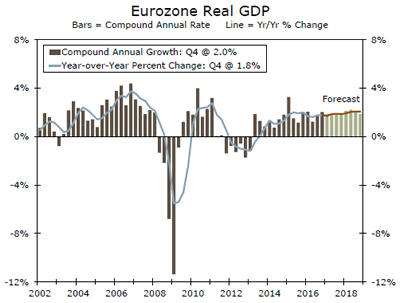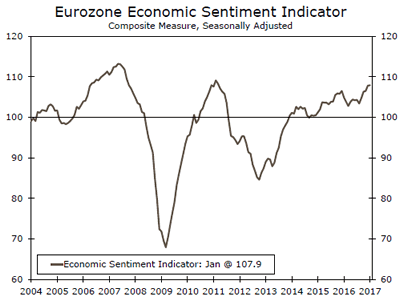U.S. Review
Yellen on The Hill
- Retail sales grew a stronger than expected 0.4 percent in January, a sign that consumer spending will continue to be a solid support to GDP growth in Q1.
- Inflation measures surprised to the upside in January with both the Consumer Price Index and the Producer Price Index climbing 0.6 percent for the month. Core inflation measures also remained firm for the month.
- Housing starts fell 2.6 percent in January after rising 11.3 percent in December. Single-family starts still posted an increase for the month. The more forward looking permit data indicated that the downshift in starts may be temporary.
Yellen on The Hill
Federal Open Market Committee (FOMC) Chair Yellen went to Capitol Hill for her semiannual testimony. While uneventful for the most part, clear signals were sent that the FOMC intends to hike rates at a slightly faster pace this year. With respect to understanding when the FOMC may decide to halt reinvestments of maturing portfolio holdings, Yellen indicated that in order to consider reducing the size of the Fed’s balance sheet, the committee wants to ensure that "the economy is on a solid course and the federal funds rate has reached levels where we have some ability to address weakness by cutting it." She reiterated the Fed’s monetary policy normalization principals including the fact that the committee will continue to reinvest principal payments on maturing assets until "normalization of the level of the federal funds rate is well underway."
Retail sales data for January posted an impressive 0.6 percent gain on the back of a one percent rise in December. Control group sales, which feed into the calculation of GDP, rose 0.4 percent to start the year. Some of the gain, however, is likely due to higher inflation boosting the nominally reported sales figures. Headline CPI rose 0.3 percent in January, taking the year-over-year rate of consumer inflation to 2.5 percent. Core consumer inflation edged higher to 2.3 percent on a year-over-year basis. Taken together, we remain comfortable with our call for real consumer spending to expand at a 2.7 percent pace in the first quarter, slightly stronger than the 2.5 percent pace observed in the fourth quarter of 2016.
Housing starts fell 2.6 percent in January to a 1.25 million units pace after posting an impressive 11.3 percent gain in December. The more volatile multi-family starts pulled back for the month while single family starts rose 1.9 percent. The forward-looking housing permits data indicated that the downshift is likely temporary. The NAHB/Wells Fargo Housing Market Index fell in February suggesting that some of the post-election jump in builder sentiment has begun to fade. Looking ahead to the rest of this year, we continue to expect home building activity to remain steady with housing starts climbing to 1.22 million units from 2016’s 1.17 million units put in place.
Industrial production fell 0.3 percent in January as a drop in utilities output weighed on the index. The plunge in utilities output due to the warmer weather for the month was the largest declines since January of 2006. Manufacturing output rose 0.2 percent in a sign that the sector was slowly improving. That said, the industrial sector of the economy continues to face headwinds from a strong U.S. Dollar and soft global demand.
Business inventories rose 0.4 percent in December in an early sign that businesses are beginning to feel a bit more optimistic about future growth prospects. Total sales were up 2 percent with gains across the supply chain. Inventories have boosted growth over the last couple of quarters but given that the pace of sales and inventory building appear to be more in line, we expect inventories to have a negligible effect on GDP growth this year.
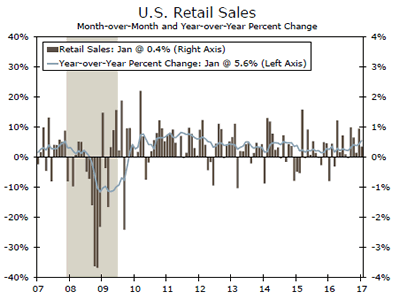
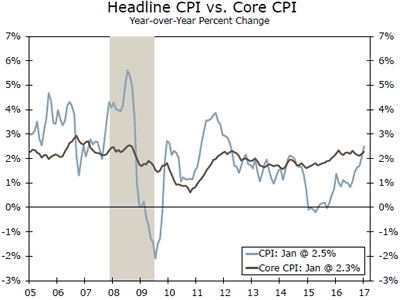
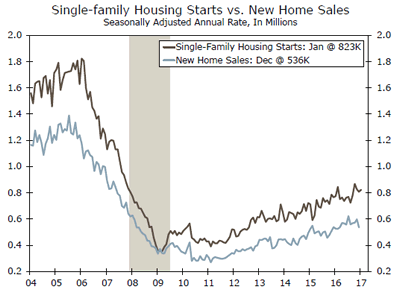

U.S. Outlook
Existing Home Sales • Wednesday
Following three straight monthly gains, existing home sales slipped 2.8 percent to a 5.49 million-unit annual rate in December. Despite the drop, existing home sales rose solidly in 2016, with total sales increasing 3.8 percent to finish the year at 5.45 million units—the highest level since 2006.
Lean inventories continue to restrain resale activity, however, with homes available for sale down 6.3 percent year over year. The supply of lower-priced homes has been particularly tight, with sales of homes priced under $100,000 accounting for a smaller share of overall sales in recent years. The lack of listings at more affordable price points, coupled with higher borrowing costs, will likely continue to hold back first-time homebuyers.
We look for existing home sales to rise a modest 1.5 percent in January to a 5.57 million-unit annual rate.
Previous: 5.49 Million Wells Fargo: 5.57 Million Consensus: 5.55 Million

New Home Sales • Friday
New home sales ended 2016 on a weak note, falling 10.4 percent in December. Despite the monthly decline, home sales rose a solid 12.4 percent in 2016, increasing to 563,000 homes. Home prices have continued to rise, with the median price of a new home increasing 5.7 percent over the year to $313,200. Homebuilders have struggled to contain housing costs as supply-side issues including labor shortages and lack of buildable lots are driving prices higher.
A spike in mortgage rates likely dampened sales in December. On average, mortgage rates were 43 basis points higher in December relative to the prior month, rising to 4.2 percent. While interest rates remain historically low, we expect home sales to rise modestly in the first half of 2017 as consumers adjust to higher borrowing costs.
Previous: 536,000 Wells Fargo: 566,000 Consensus: 575,000

Consumer Sentiment • Friday
University of Michigan’s consumer sentiment index inched up in January to a cycle-high at 98.5. The elevated reading coincides with other survey measures that increased markedly in the wake of the U.S. presidential election, in part, due to heightened prospects for economic growth. The preliminary February release reported a decline in sentiment, however, with the majority of the softness occurring in the expectations component.
The U.S. consumer has been the backbone of the current economic cycle, supported by a relatively strong recovery in employment and some help from real personal income growth. The better-thanexpected retail sales report this week was an encouraging signal of continued consumer strength. We look to next week’s sentiment indicator for further clarity on consumers’ attitudes about future spending.
Previous: 95.7 Consensus: 96.0

Global Review
Japan Strings Together Four Quarters of Growth in 2016
- Preliminary estimates released this week suggest that the Japanese economy expanded at an annualized rate of 1.0 percent in the fourth quarter.
- While that was a shade lighter that most analysts had forecast, it marks the first time that Japan has had positive GDP growth for all four quarters of the year since 2005.
Japan GDP Expands for Fourth Quarter
Advance estimates for fourth quarter GDP in Japan were released this week and while the figures were generally weaker-thanconsensus expectations, the report affirms that the trade-led recovery in Japan continues. The annualized growth rate of 1.0 percent was a shade softer than the 1.1 percent that had been expected. However, it was the fourth straight quarterly increase— the longest stretch of uninterrupted growth since 2013. In addition, it is the first time the Japanese economy has expanded in all four quarters of a calendar year since 2005.
Net exports have been a steady driver of Japanese growth in recent quarters and that was the case here in the fourth quarter as well. Despite the fact that consumer spending was unchanged, imports increased 1.3 percent. The demand pull came from the business sector as business investment climbed 0.9 percent. Exports, meanwhile, increased 2.6 percent.
It has been more than four years since Prime Minister Shinzo Abe came to power in Japan largely on a platform to lift the Japanese economy through fiscal and monetary expansion and other structural reforms. While the track record of Abenomics has been mixed, this fourth quarterly increase is something of a milestone. Given the important role of trade in the Japanese expansion, it is little wonder that Prime Minister Abe was eager to meet with his newly elected counterpart in the United States last week. After years of diplomacy with the Obama administration to shore up support for the Trans-Pacific Partnership, the dismissal of that trade pact by the new U.S. president is certainly not a positive development for Japan.
The United States and China are roughly tied for the spot of Japan’s largest export market, with Korea coming in a very distant third, so some eagerness on Abe’s part to work out a bilateral trade deal is understandable.
BoJ Still Supportive
In January, the Bank of Japan (BoJ) increased its forecast for 2017 GDP to 1.4 percent from the 1.0 percent forecast it had previously. The BoJ is not likely to alter its current policy based on this latest GDP report.
The BoJ is still engaged in what it has called "yield curve control," which it maintains through a negative short-term policy rate and by engaging in purchases of 10-year Japanese Government Bonds (JGB) such that the yield on 10-year JGB remains at or near zero. The BoJ’s asset purchase program, which is injecting cash into the financial system via bank purchases of a variety of financial instruments, including ETF and REITs, is also still ongoing as are various fund provisioning measures to stimulate bank lending and to provide relief for disaster areas affected by earthquakes. The ¥28 trillion fiscal stimulus is also underway in Japan and should underpin growth through the first quarter. In short, fiscal and monetary policies in Japan are both supportive; continued improvement in global growth and healthy trade could help the Japanese economy stretch its win streak to five quarters.
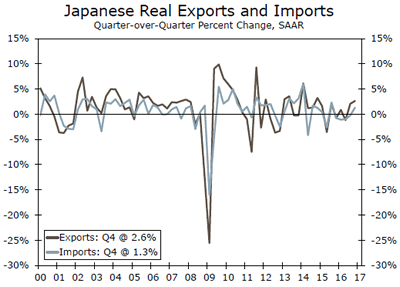


Global Outlook
Eurozone Manufacturing PMI• Tuesday
After recording the highest level in almost three years, up to 55.2, the Eurozone preliminary manufacturing PMI for February is scheduled to hit the wire next week. The Markit Eurozone manufacturing PMI has been coming up slowly and uninterrupted since August of last year and a new strengthening of this index in February could continue to push expectation of an overdue manufacturing recovery in the region, following a similar pattern at this side of the Hemisphere.
With the weakening of the euro over the last year or so the expansion in manufacturing is probably expected to continue as the global economy continues to improve and manufacturing output from the region regains some lost competitiveness over the previous years.
Previous: 55.2 Consensus: 55.0

Germany Manufacturing PMI • Tuesday
The German Markit/BME manufacturing PMI is also on the docket for Tuesday and similarly with the Eurozone index, the January reading was the highest in almost three years, up to 56.4 from a previous reading of 55.6 in December. It is clear that it is Germany in the driver’s seat of the manufacturing recovery in this cycle, something that should not surprise those that follow the German economy and the overall Eurozone economy.
Germany is also going to release its IFO business climate report, economic expectations index, as well as its current economic assessment for February on Wednesday. The first two of these indices were a tad lower on January while the third one was slightly better. We will also see the final reading on Q4 GDP and whole year GDP, which includes all the demand components. Meanwhile, closing the week we will get the Gfk consumer confidence index for March, which hit a high of 10.2 in February.
Previous: 56.4 Consensus: 56.0

Mexico Q4 GDP • Wednesday
Although Mexico released a "flash" GDP result for the last quarter of 2016 and for the whole year, the statistical institute is in the docket to release the more informative supply side GDP sector breakdown on Wednesday as well as the economic activity index for December of 2016. From the economic activity index we will be able to gauge the strength of the Mexican economy during the last month of 2016 while from the broader supply side result we will be able to make some inferences on the demand side of the economy by looking at commerce, construction, utilities, hotels, manufacturing, etc.
It is clear that the slowdown that has hit the productive sector over the last year or so has still to be reflected in domestic demand so this first exercise at inferring demand side components from the supply side could yield some more insights from what we should expect for the Mexican economy in 2017.
Previous: 2.2% Consensus: 2.0%
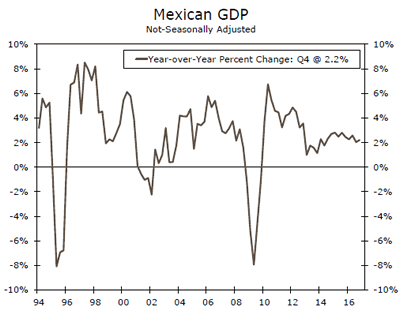
Point of View
Interest Rate Watch
Highlights from the Hill
If markets were looking for a strong hint that the FOMC would make its next move as soon as the March meeting, they did not get it from Chair Yellen this week. In her semi-annual testimony to Congress, Yellen held a steady line between emphasizing the continued progress in the economy and that only gradual increases in the fed funds rate would be warranted.
Stronger inflation readings from the PPI and CPI this week helped to raise market expectations for a fed funds rate hike in March. On Monday, markets were pricing in a 30 percent chance of a rate hike with the probability rising to 44 percent on Wednesday after the CPI release. However, with Yellen’s view of inflation appearing little changed after these reports, market expectations for a March increase have fallen back to the low 30s. We continue to expect the next rate hike to come in June.
Fiscal Policy Only Part of Equation
Much has been made about the potential for faster tightening this year amid plans for more supportive fiscal policy. Yet here too Yellen’s outlook seemed little changed from previous comments. With little detail on what fiscal policy may look like, Yellen remains hesitant to alter her outlook at the moment. And while any changes in fiscal policy are more likely than not to be supportive of growth, she also emphasized that U.S. fiscal policy is only one of many factors influencing monetary policy.
No Plans for the Balance Sheet
With markets more convinced that the Fed will raise rates multiple times this year, increased attention has been put on the Fed’s balance sheet. In her remarks, Yellen noted that the Fed will continue its policy of reinvesting maturing debt.
When pressed on the timing of such a policy change, Yellen said shrinking the balance sheet would not occur until interest rates were high enough to where they could be meaningfully cut if the economy weakened. In other words, the FOMC remains in no hurry to shrink the balance sheet despite some regional Fed presidents beginning to discuss it more publicly.



Credit Market Insights
Consumer Credit Standards Tighten
Consumer credit standards tightened modestly in the fourth quarter according to the most recent Senior Loan Officer Opinion Survey. A net 3.1 percent of bank respondents reported being more willing to make consumer installment loans, down from 12.5 percent in Q3. The decline coincides with the cyclical trend witnessed over the past several business cycles, which shows banks’ willingness to lend picking up early in economic recoveries and falling in the latter stages of the business cycle.
Lending standards for consumer loans tightened modestly across the board in the fourth quarter. A net 8.3 percent of banks reported tightening standards for credit cards, which marks the first quarter of net tightening since 2010. Similarly, standards for auto loans also constricted with a net 11.7 percent of lenders tightening standards, the largest share since 2011. Notably, banks expect to continue to tighten auto lending standards in 2017. On the flip side, the majority of banks expect to ease lending standards for mortgage loans over the year, which should help offset some of the drag from rising interest rates.
Despite the signs of some modest tightening in consumer credit standards, household leverage remains low relative to the bubbly period before the Great Recession. In addition, the tightest labor market in a decade ought to spur a pickup in wage growth in 2017, which should help keep personal consumption growth on solid footing.
Topic of the Week
Populist Push in Europe
Populist and nationalist forces appear to be ascendant in many countries. Three large Eurozone economies, the Netherlands, France and Germany, hold important elections in coming months, elections that may determine the future of the Eurozone. Approaching quickly is the election to the Dutch parliament, which will be held on March 15. The populist Party for Freedom (PVV), an anti-immigration and anti-EU party, is expected to garner the most votes. However, a plurality of votes, rather than a majority, means that the PVV would have to form a coalition government, and most centrist parties have ruled out cooperating with the PVV. That said, a better-than-expected showing by the PVV could induce a negative market reaction.
France’s presidential election, which contains two rounds, will occur on April 23 and May 7. Marine Le Pen, the leader of the EU-skeptic National Front, likely would be one of the top two vote-getters if the first round of the French presidential election were held today. However, most polls currently show that either François Fillon, leader of the center-right Republicans and Emmanuel Macron, leader of the independent En Marche! party would handedly beat Le Pen by 60 percent or more of the vote in a second round. However, if political events since last June have taught us anything it is that political polls can be widely off the mark. Could a President Le Pen unilaterally take France out of the European Union? No. EU membership is enshrined in the French constitution, so "Frexit" would require an amendment to the French constitution.
Germany, will hold elections for the Bundestag, the lower house of the German parliament, on Sept. 24. Angela Merkel, who is the leader of the CDU and who has been the German chancellor since November 2005, is in a neck-to-neck race to retain her chancellorship. The probability that an EU-skeptic party comes to power in Germany following the Sept. 24 Bundestag elections is even lower than it is in either the Netherlands or France. The full report can be found on our website.
